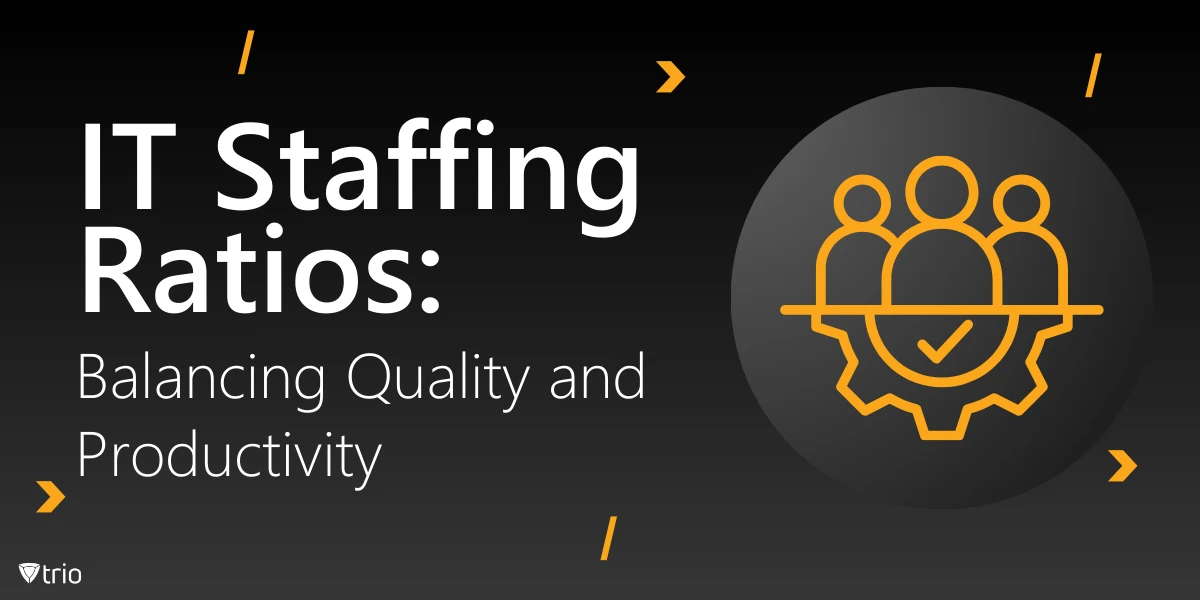Organizations balance their digital ambitions with teams sized to handle tasks efficiently. Central to this concept, IT staffing ratios guide decisions regarding how technicians align with system demands. Each well-planned ratio affects output, ensuring both scarce expertise and redundant labor are sufficient to maintain operational flow. The entire enterprise thrives when equilibrium shapes workforce allocation.
Maintaining quality without strangling performance requires a deliberate blueprint. An IT asset management strategy ensures each tool, from software suites to server racks, finds proper oversight. This careful orchestration lets individuals concentrate on priority work while robust frameworks safeguard data, enhance reliability, and maintain confidence. When discipline meets clarity, entire systems hum.
Thoughtful calibration of team size and skill distribution shapes timely project completions. Minimizing excessive downtime, predictable processes, and accessible support form an ecosystem that keeps everyone content. Employees appreciate stable environments, forging trust and pride in their daily responsibilities. Ultimately, planned ratios nurture synergy. With careful attention, outcomes remain sturdy across changing landscapes.
Understanding IT Staffing Ratios
Information technology staffing ratios calculate numeric relationships linking IT professionals and the systems they maintain. Instead of guesswork, these measures define how expertise aligns with hardware, software, and user bases. Observing these figures illuminates why certain operations hum efficiently while others flounder under chaotic resource distribution. Clarity emerges from patterns found within these structural choices.
These ratios function akin to architectural blueprints, guiding resource placement and balance. When measured carefully, staffing structures reflect actual workload intensity, ensuring neither wasted talent nor overburdened personnel. As reference points, they transform intangible concepts into metrics leaders can evaluate, adjust, and improve methodically. With thoughtful interpretation, complexity becomes approachable.
Some observers crave universal norms to compare performance quickly. Yet what applies to sprawling international enterprises may not fit compact local firms. External guidelines frame expectations, though actual operations demand flexible criteria reflecting unique histories, goals, and cultures. Adaptation outperforms rigid adherence every single time. Practical wisdom trumps formulaic compliance.
Learning how these numbers interact prepares teams for strategic decisions amid shifting demands. Once people grasp underlying logic, scaling infrastructures or testing novel solutions runs smoother. Informed leaders leverage knowledge as a tool, ensuring decisions emerge from solid evidence rather than empty guesswork. Insight fosters confident action.

Key Factors Influencing the Ratio
An array of forces shape the ideal management-to-staff ratio within IT realms. Enterprise size and diversity of applications steer headcounts in different directions. Highly regulated sectors prioritize security experts, while lean startups allocate generalists capable of handling unpredictable challenges. Every choice grows from internal contours. No blueprint remains static.
Distinguishing between on-premises architectures and evolving cloud environments influences patterns of staffing. Traditional deployments may demand steady in-house expertise, while cloud-based solutions open doors to specialized external partners. Regulatory compliance further refines responsibilities, prompting careful alignment of each role with the demands of legal frameworks. These variables cooperate or collide, forming intricate patterns.
IT department roles display unique blends of technical acumen, project management capabilities, and interpersonal finesse. Some teams host seasoned specialists who master complex networks, others thrive with versatile professionals who pivot as needs evolve. As skill sets expand, the ratio morphs into something rich and dynamic. Every arrangement reflects both strategy and talent.
Business trajectories intersect with constantly shifting technological landscapes, reconfiguring staffing patterns frequently. A booming enterprise scaling new platforms demands fresh hires, while stable companies refining legacy systems rely on entrenched expertise. Leaders must reassess their allocations regularly, staying attentive to signals from across operational layers. Adaptation proves indispensable. Nothing remains fixed for long.
Approaches to Defining an Ideal IT Staffing Ratio
Establishing a stable starting point involves grounded approaches like workload analysis or careful interpretation of service-level agreements. Observers track incident frequency, average resolution times, and user demands. Each data set indicates whether current staffing suffices or requires refinement. Rational starting points govern IT support allocation patterns. This ensures clear baselines.
Once baselines emerge, periodic assessment reveals shifting demands or evolving user expectations. Regular feedback loops refine these initial guesses, strengthening underlying logic as circumstances change. Metric reviews surface subtle imbalances, signaling incremental adaptations. Steady calibration ensures neither overstaffing nor understaffing holds projects hostage. Gradual improvements quietly forge lasting strength.
Pursuing fiscal discipline never requires sacrificing operational resilience. Through careful scaling, teams maintain an equilibrium between strategic investments and practical outlays. Even lean configurations deliver results, provided their workflows synchronize with corporate goals. Every financial decision resonates across departments, shaping landscapes where adaptability thrives. Clever tactics maximize outcomes.
Input from end-users, technical leads, and stakeholders fosters decisions grounded in reality. Dialogue encourages consensus, preventing misguided assumptions. As dynamic circumstances unfold, defined guidelines relax or tighten. Trusted advisors revisit metrics whenever disruptive technologies enter the scene, ensuring equilibrium remains reliable.
Real-World Benchmarks and Industry Standards
Certain industries embrace IT staffing ratios benchmarking metrics and analysis that highlight patterns visible across global sectors. A multinational corporation overseeing thousands of endpoints sets a distinctive threshold. Meanwhile, mid-sized enterprises working within narrower scopes adopt distinct reference points. Benchmarks hint at guiding values without dictating compliance. Truly universal standards rarely exist.
Large conglomerates often allocate substantial internal teams familiar with intricate infrastructures. Smaller outfits outsource workloads to external specialists who supplement in-house efforts. Managed IT services providers integrate seamlessly, handling tasks that would overwhelm tiny groups. Each approach illustrates unique ecosystem demands reflected in specific ratios. Operational agility emerges from suitable collaborations.
Detailed analyses by respected consultancies and research bodies provide numeric targets worth consideration. Some frameworks aggregate data from hundreds of organizations, revealing broad patterns that inform decision-makers. Reading industry reports equips leaders with practical insights. Inspired by evidence, they select benchmarks that fit their narrative.
Conventional wisdom suggests treating these figures as primers rather than rigid formulas. Initial values set expectations, and flexibility remains essential to accommodate sudden growth or evolving systems. While comparisons help define initial directions, ongoing introspection ensures adjustments. Over time, organizations learn from collective experience.
Leveraging Automation and Other Tools to Optimize Productivity
Implementing IT process automation addresses routine maintenance tasks that previously drained human energy. AI-driven tools observe systems, anticipate anomalies, and react promptly. Automated orchestration regulates software updates and ensures consistent performance. Freed from mundane chores, technical staff reallocate energy toward creative initiatives. In this climate, innovation thrives, and complexities become manageable.
Intelligent ticketing systems minimize response times, ensuring each query lands with an appropriate responder. Self-service portals empower users, enabling certain actions without staff intervention. As these tools mature, the ratio between technicians and end-users shifts, reflecting heightened productivity. Efficiency emerges as a natural consequence.
Wisely chosen tools release skilled professionals from mundane obligations, granting a chance to tackle deeper complexities. Instead of drowning in ticket queues, they pursue strategic initiatives that propel infrastructures into fresh frontiers. Proper technology investments yield returns reflected in stable metrics. Balanced staffing thrives here. Progress aligns with resourceful action.
As automation cements routine activities, teams uncover opportunities to refine architecture and bolster security. Freed minds conceptualize enhancements, no longer trapped by endless troubleshooting. Over time, strategic thinking replaces repetitive toil. This environment sparks agility, where the human element excels beyond rigid formulas.

Evaluating and Adjusting the Ratio Over Time
Periodic evaluation prevents stagnation within information technology operations. Performance reviews highlight strengths and reveal vulnerabilities. Key performance indicators track system uptime, incident resolution speed, and user satisfaction.Detailed analytics illuminate subtle trends that shape staffing decisions.Ongoing vigilance wards off complacency. Transparency enhances adaptability. Steady refinement anchors improvement. Timelines benefit from thoughtful analysis.
Adjusting headcounts, redistributing responsibilities, or outsourcing tasks remain viable tactics when shifts occur. An expanding enterprise demands tech specialists who safeguard new
ventures. Conversely, a stable environment might contract staff without sacrificing resilience. Regularly revisiting ratios verifies alignment with organizational realities.
Fixed formulas fail when confronted by changing requirements. Adaptive thinkers embrace flexible strategies to maintain optimal ratios. They listen closely to feedback from multiple sources. Continuing education, cross-training, and thoughtful mentoring expand capabilities. Over time, iterative enhancements become embedded traditions.
Regular check-ins catch emerging issues before they metastasize. Overlooked imbalances surface under scrutiny, prompting timely tweaks. Even modest changes produce cumulative benefits. Through incremental refinements, trust builds among employees, customers, and investors. Ultimately, flexible staffing ratios enrich outcomes.
Trio: Your MDM Partner
Entering a landscape where stable staffing matters demands tools that safeguard devices and data. Mobile device management (MDM) platforms streamline oversight, ensuring smooth governance of distributed endpoints. Trio emerges as a capable ally, blending user-friendly interfaces with adaptable configurations. By harnessing Trio’s features, organizations transcend guesswork.
With flexible controls, continuous updates, and a platform built to align with evolving strategies, Trio ensures secure operations. Experimentation becomes simpler as teams test configurations within a stable environment. Users can try Trio’s free demo, exploring capabilities that support smart allocation. The path forward awaits exploration. As horizons expand, productivity grows unimpeded.
Conclusion
Achieving equilibrium between technical staff and system demands shapes enduring operational health. Each organization crafts ratios unique to its ambitions, complexity, and constraints. Rather than chasing perfect formulas, focus turns toward dynamic interaction between capable professionals and evolving infrastructures. Balance defines a continuous pursuit.
See Trio in Action: Get Your Free Trial Now!
Rather than fixating on static benchmarks, strategic adjustments guide resource distribution. Fleeting trends require careful reevaluation, ensuring systems remain robust and cohesive. Thoughtful adaptation, supported by evidence and insight, nurtures environments where excellence flourishes. Skilled leaders respect flux, welcoming lessons from shifting conditions. Steady increments shape tomorrow’s landscape.
In the end, balanced staffing ratios evoke sustained value within every layer of an organization. Rather than one-size-fits-all templates, leaders experiment, refine, and discover new efficiencies. With persistence, emerging technologies evolve into catalysts, improving resilience. Informed decisions forge lasting success.




